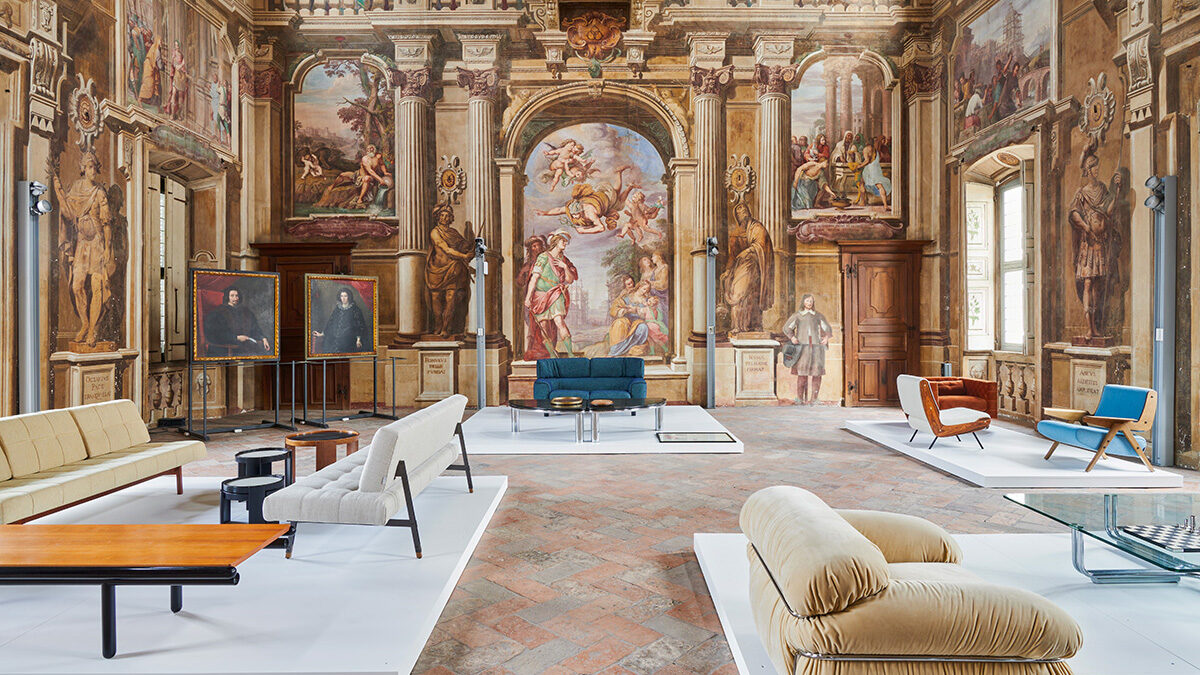The thoughts of Massimo Gianquitto, Level Office Landscape’s CEO, about the Gianfranco Frattini exhibition held on the main floor of Palazzo Arese Borromeo, in Cesano Maderno.
During the Salone del Mobile and the Fuorisalone events in Milan, brands organized so many initiatives that was impossible to allow anyone to visit them all, without neglecting some beautiful and unmissable news. Even more the one out of the city, such as the exhibition dedicated to a protagonist of Italian design: “Gianfranco Frattini, yesterday, today, tomorrow” was housed in the frescoed rooms of the noble floor of Palazzo Arese Borromeo, in Cesano Maderno (MB).
Gianfranco Frattini Exhibition
Anyone who missed this appointment loose a double chance. The one to know the masterpiece of a suburban noble residence in the late Lombard Baroque style, built from 1654 to 1670 by the Arese family, then completed over the years by the branch of the Borromeo family (however, it can be visited all year round), and the exhibition set up on the noble floor.
“One of the most interesting legacies, remains from Fuorisalone 2023 because it teaches us many things about design”. As Elena Cattaneo wrote in an article dedicated to the master Gianfranco Frattini, published on Interni Magazine in April 2023. Anyone who had the opportunity to visit the exhibition was certainly surprised. In fact, he was able to walk through the magnificent frescoed halls, which however do not retain the original furnishngs, triansferred in 1987 in Palazzo Borromeo in Isola Madre of the Borromeo Princes, direct heirs of the Arese, to make room for those of well-known design brands.
The unsuspecting visitor will have drawn a sensation of perfect harmony, of timeless beauty, of that perfect union and of the much declared, but very difficult to achieve, balance between the historical context of the building and the modern design. Arriving in the hall, a majestic environment completely covered by seventeenth-century frescoes, hosted numerous upholstered furniture designed by Frattini for companies such as Cassina, Ceccotti, Poltrona Frau and Tacchini.
The Dialogue Between Classicism and Contemporaneity
Those sofas, armchairs and coffee tables, which seem to have been designed for that place, find themselves conversing with respect in a context out of their time. Thus they demonstrate that good design is capable of measuring itself over time, facing the most formidable challenges.
Gianfranco Frattini’s is more than a product designer born in his words, in “a period, not too far away, in which design wasn’t called yet like this and those who designed furniture and objects for the house wasn’t labeled as designers. There is a territory of Italy, from Milan to Brianza, where it all began, thanks to the favorable meeting between architects, expert craftsmen and enlightened entrepreneurs“.
Connosseur of the materials, Frattini masters them to make products by exploiting their natural characteristics, He draws constantly: “He alwayshad a pencil in his hand”, recalls his daughter Emanuela Frattini: egaged in that strenuous research and attention to detail, as if the quality of the project resided right there, capable of expressing an idea of beauty that does not coincide with what he means by luxury.
The Exhibition Devoted to Gianfranco Frattini
Halfway through the exhibition itinerary, the visitor is invited to sit on wooden chairs designed by Frattini (it is not difficult to read the more or less explicit references of contemporary designers who have been inspired by him, demonstrating the greatness and relevance of his lesson) leaving accompanied by his words. He studied with Gio Ponti and Portaluppi at the Milan Polytechnic.
The exhibition continues with an overview of the objects designed by Frattini, among the most varied: trays, containers, lamps, frames, some still in production while others no longer. A magnificent room collects a series of interior projects created by him, presenting original sketches and technical drawings, from which one perceives not only his great dexterity, but the ability to create new forms of furniture to respond to new needs and of the rapidly changing society of the 1950s and 1960s.
Gianfranco Frattini was a man and professional attentive to the changes and innovations produced over the years such as the plastic revolution. He responded with the helmet project, a yellow construction helmet for Montecatini in 1963. At the end of this exhibition, one gets the impression of having known him forever and having appreciated his products not because they are the answer to the fashions of the moment, but because they express the seriousness of a profession, an overview of the work, an idea nostalgia for something that perhaps no longer exists, but that designers should find again.
